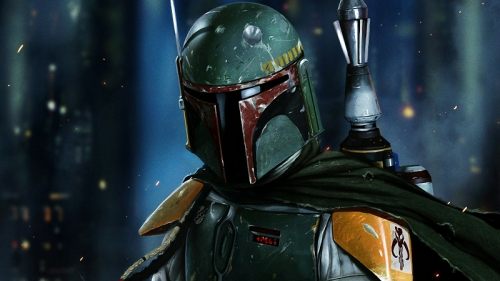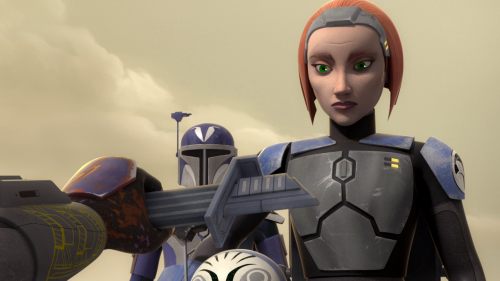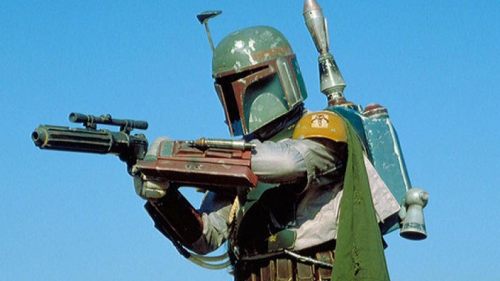JEDI: FALLEN ORDER Game Review: The Rise Of Wallrunner
Star Wars is best when it’s about something, and when it expands the universe George Lucas created. Respawn Entertainment’s new Star Wars game Jedi: Fallen Order - the first single-player Star Wars title since EA scored the franchise rights - does both. It's well and truly about something, and it both adds new colour to established Star Wars canon, and carves new niches all to itself. It’s also, by the by, quite good as a game.
Tragically-stonefaced protagonist Cal Kestis begins the story as a scrapper at a shipbreaking yard, but upon the arrival of an Imperial Inquisitor known as the Second Sister, he's quickly outed as a Jedi in hiding - not a great look in this post-Revenge of the Sith timeline. Rescued by former Jedi Cere Junda, four-armed pilot Greez Dritus, and adorable two-legged shoulder-droid BD-1, Cal is swept into a proto-Rebellion quest to reinstate his connection to the Force, locate a space-Rolodex of remaining Force-sensitive children, and rebuild the Jedi Order - while being pursued by the Second Sister and associated goons. Canonically, they cannot succeed - but their success or failure isn't what the game's really about.
Fallen Order visits half a dozen planets in the Star Wars galaxy, delving into several canonically important but largely unexplored locales, each sprawling with unique environments and secrets. On crumbling Zeffo, you can pick over a crashed prequel-era Star Destroyer. On verdant Wookiee homeworld Kashyyyk, the game more or less turns into Avatar. On icy Ilum (possibly the location of The Force Awakens’ Starkiller Base), you plunder crystal caves to build a new lightsaber. On red-sunned Dathomir, the game dives into Force witchcraft, the undead, and giant beasties straight out of Dark Souls. Scannable items and enemies open up bite-sized info-dumps and tell microstories from the surrounding area. Familiar Star Wars characters - Forest Whitaker reprising Saw Gerrera; Tarfful the Wookiee, others I shan't spoil - rub shoulders with some of my favourite new characters in the new canon. It’s a nonstop parade of astonishing vistas, weird creatures, and delightful new corners of the universe that makes The Mandalorian look downright pedestrian. The original score, too, evokes John Williams but only rarely reprises his themes, creating atmosphere that feels fresh and familiar at once. There’s even a goth-rock answer to the Cantina Band. It’s a good time.
Those worlds are more than just pretty scenery. While the game's jumping, climbing, and swinging might look like Uncharted, in its exploratory zeal it’s more of a Metroid. Open up BD-1’s holographic map, and you’ll see just how huge and interconnected the maps are. As Cal (and BD-1) unlock new acrobatic, Force, and technological abilities, new paths open up into an anthill-like network of shortcuts. Without fast-travel, you'll use those shortcuts a lot, too, quickly learning the quickest paths between the liberally-distributed Souls-like meditation points. (I hope they don't add fast travel, either; I'd rather spend thirty seconds jumping through an environment than staring at a loading screen.) Most optional paths yield cosmetic items or bits of lore - and nearly all grant a terrific feeling of discovery.
Lightsaber combat is the yardstick by which Jedi-centric games are measured, and in taking after Sekiro: Shadows Die Twice (among others), Fallen Order’s duelling delivers a precision experience with quite the skill ceiling. Based around parrying, dodging, and timing attacks, Fallen Order's combat is a little more forgiving than Souls games' - but not by much. Getting surrounded is often a death sentence, and the sheer variety of creatures and Imperials mandates a varied bag of combat tricks. Upon death, you lose any unspent XP, regained by damaging the enemy that killed you; in an odd bit of cognitive dissonance, XP and Force energy are replenished by killing things (not very Jedi-like). XP can be spent on upgrades and abilities that feel nicely meaningful, most requiring conscious use in combat. And though you can comfortably slash through anything at the lowest difficulty level, certain encounters at higher difficulties will test even the most devoted Souls fan.
Unlike Souls games, however, Fallen Order also features scripted setpieces that frequently amaze, ranging from a thrilling train escape to a drawn-out battle with a gargoyle; from an illicit fighting pit to an underwater Imperial base. Respawn inserted perhaps a few too many “the floor caves in and you slide down a slope to a new area” bits, but the action is as big and weird as the biggest, weirdest sequences from the films. Even interplanetary travel is made more interesting by allowing you to walk around your ship and peep out the windows as you go from surface, to space, to hyperspace, to surface again. It’s helped along by expressive animation, stunning art direction, and quality voice acting, though I pity the actor who had to play the blank slate that is Cal.
What is Fallen Order about, though? Initially, I read “Fallen Order” as a generic Jedi-adjacent title, but it’s actually central to the story, which is all about the trauma of Order 66 and the Jedi Purge that followed. One flashback sequence forces you to fail at saving your own master, staged with spectacle and drama alike. Another sequence has Cal literally face his fears for the future. Cal is uniquely able to "feel" the history of people or objects, meaning he’s constantly bombarded by second-hand traumas past. The game’s Jedi Vault dungeons yield not just enjoyable Zelda-ish puzzling, but an ongoing backstory that even lends pathos to chirpy little BD-1. Every major character in Fallen Order conceals some pain or guilt, and even the villains become sympathetic by the end. It paints a grief-stricken picture of the early-Empire Star Wars galaxy we haven't seen before, illustrating tragedy far more compelling than any statistic (or montage) of Jedi assassinations. Much like its influences, Fallen Order’s difficulty exists not just in the game mechanics, but in the characters' souls.
Jedi: Fallen Order isn't original, exactly. It mixes the combat of Sekiro with the traversal and cinematics of Uncharted, the setting of Star Wars, the exploration of Metroid, the kineticism and pacing of Titanfall 2, the puzzling of Zelda, and - incredibly - the dual protagonists of Banjo-Kazooie. Despite frame-rate drops and loading-zone pauses, it’s exceptionally well-made, synthesising its influences to, somehow, regularly surprise the player over dozens of hours. Fallen Order also innovates within the Star Wars universe, further detailing areas we knew and branching out into areas we didn’t. Early on, a character tells you to perform a task “faster” and with “more intensity.” In addition to being a cheeky George Lucas reference, that also seems to have been the rallying cry for the game itself. Imaginative, exciting, and unexpectedly emotional, Jedi: Fallen Order is the single-player Star Wars game many have been waiting for - and one of the best in its class.



